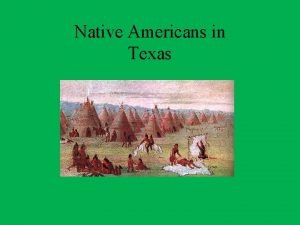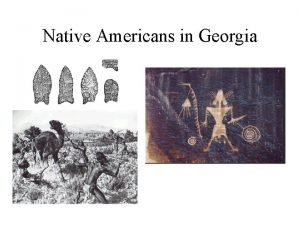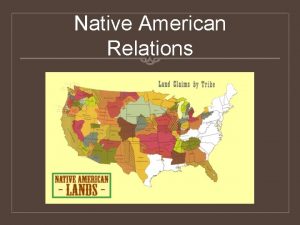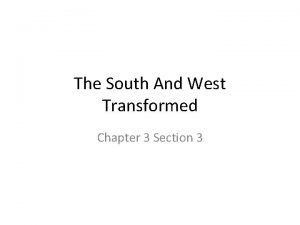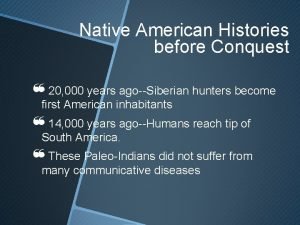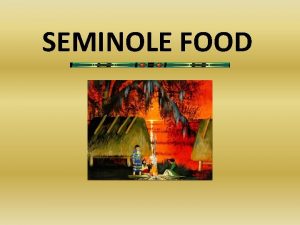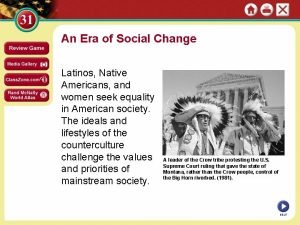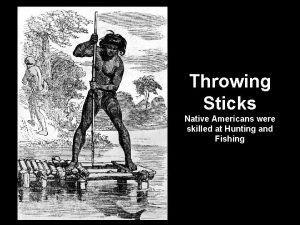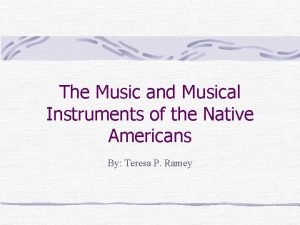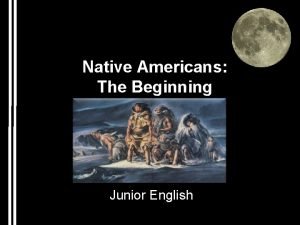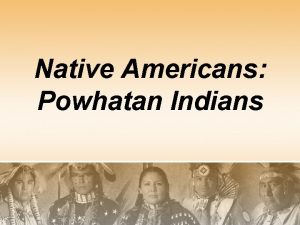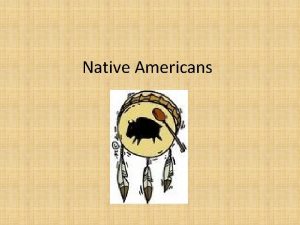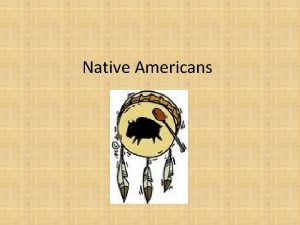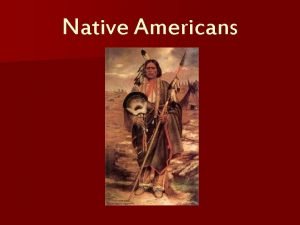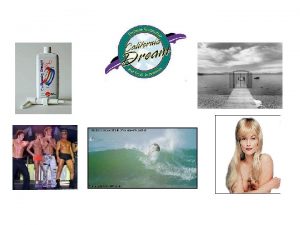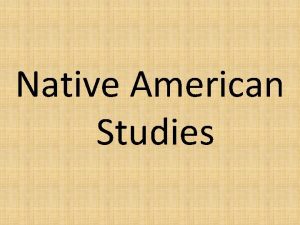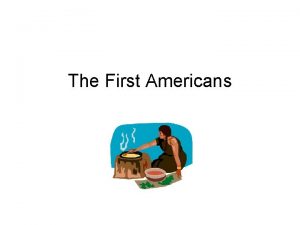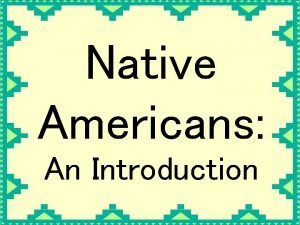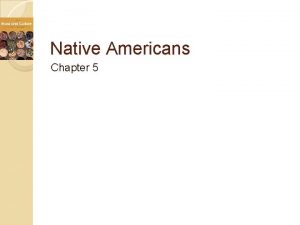NATIVE AMERICAN INDIANS THE FIRST AMERICANS A long
















- Slides: 16

NATIVE AMERICAN INDIANS

THE FIRST AMERICANS A long time ago North America was very different from the way it is today. There were no highways, cars, or cities. There were no schools, malls, or restaurants. But even long, long ago, there were still communities. A community is where a group of people live and have fun together. People made their own homes, food, and clothing from the plants and animals they found around them, or natural resources. These first Americans descended, or came from cave men of Asia. These were the first people to live in North America. That is why we call them Native Americans. These people have lived in North America for thousands of years, and there are still Indian communities today.

CULTURAL REGIONS Often people living in the same area share some ways of life. Such an area is called a cultural region. People living in a place with cold weather, for example, wear heavy clothing. Many people living in a place with rich soil farm the land. Yet in North America, there were great differences even among the people of the same cultural region. Think about these differences as you read about each cultural region. Cultural Regions

NORTHWEST COAST The Northwest Coast Indian Culture was in what is today the states of Washington, Oregon, and northern California. Many small tribes such as the Makah and the Chinook lived in this cultural area. The tribes in this culture were much smaller than the other cultures. Northwest Coast

NORTHWEST COAST: ENVIRONMENT, FOOD, AND SHELTER Indians of the Northwest Coast lived between the ocean and rugged mountain ranges. The growing season was short, and the climate was too wet for much agriculture. There were plenty of fish, especially salmon. There were also deer and bears. There was wood to build houses and to make tools. If tribes could not get something by themselves, they could trade. People traveled by water. Northwest Coast Indians traveled in dugouts, or boats made from large, hollowed out logs. Outside each house stood a wooden pole called a totem pole. Each totem pole was beautifully carved with shapes of people and animals. The carvings showed each family’s history and importance. Northwest Coast

TRIBES OF THE NORTHWEST COAST: CHINOOKS AND MAKAHS Chinook Best known traders Lived near the coast Chinook villages made of rows of long, wooded houses. Houses were built of boards and had no windows. The Chinooks built each house partly over a hole dug in the earth so that some of the rooms were underground. Such a house is called a pit house. Several families belonging to the same clan lived in each house. A clan is a group of families related to one another. The Chinooks developed a language for trading. This trading language made it easier for different peoples to talk to each other and to barter, or exchange goods. To show off the things they owned, the Chinooks and other tribes who lived along the coast held potlatches. These were special gatherings with feasting, and dancing. During a potlatch, the hosts gave away valuable gifts as a sign of their wealth. Northwest Coast

TRIBES OF THE NORTHWEST COAST: CHINOOKS AND MAKAHS Makahs Whales were plentiful along the Northwest Coast. The Makahs built canoes to hunt the whales at sea. Makahs made wooden harpoons-long spears with sharp shell points-for whale hunting. The Makah hunted whales in a canoe. This was very dangerous because the whale might turn and cause the canoe to tip over or break the canoe in half. The harpooner stood in the front of the canoe. He always talked to the whale. He promised the whale that if it let itself be killed, it would be rewarded in the village with singing and dancing. After the harpooner had promised the whale these things, he raised his harpoon and threw it into the side of the whale. There was a rope tied to the end of the harpoon. All the men held on tightly. Eventually the whale would tire and stop fighting. Then it was harpooned until it died. Every part of the whale was used. The skin and meat were eaten, the blubber , or fat, was used for oil, and the tendons were used to make rope. The Makah kept their promise. When the whale was brought to the village there was much celebrating! Northwest Coast

SOUTHWEST The climate of the Southwest is very dry or arid. Much of the land in the southwest is desert. The Southwest has fierce heat during the day and sharp cold at night. The Southwest has very few animals because of the desert. Southwest

HOPIS Hopi means “Peaceful One” The Hopis lived in Pueblos-adobe houses of many rooms next to or on top of one another. To enter the house, people climbed ladders. All the people living in a pueblo became known as pueblo people. The early Hopi’s lived in present day Arizona. Most of their villages were built on top of mesas. Water was not in abundance. The Hopi’s used springs from under the ground and from rain showers to water their crops. While men worked in the fields, women ground corm into flour, using flat, smooth stones. Southwest

NAVAJOS The Navajos settled in the area of the Southwest known as the Four Corners. The Four Corners is where the four states of Arizona, New Mexico, Utah, and Colorado meet. The early Navajos were nomads. They often attacked the Hopis and stole their baskets, weaving looms, pottery, blankets and farm tools. The Navajos lived in houses called hogans. A hogan was a cone shaped frame covered with mud or grass. Navajos built their hogans in small, family size groups, miles apart from one another. Southwest

GREAT PLAINS Indians known as The Plains lived in the Great Plains. Buffalo was the most important natural resource of the Plains Indians of the Great Plains lived in tepees. The Plains Indians were hunters. Buffalo provided these Indians with their basic needs, food, clothing, and shelter. Great Plains

THE MANDANS The Mandans lived in forests along the Missouri River in the western land known as North Dakota. The Mandans were hunters of the buffalo and farmers. The Mandans did not live in the Great Plains but visited the Great Plains to hunt the buffalo. The Mandans lived in circular houses called a lodge. Each lodge was built over a shallow pit and covered with sod. Several families lived in one lodge. Sometimes as many as 60 people with their dog lived in one lodge. In the center of the lodge was a fireplace under a hole in the roof. The hole let smoke out from the fire. Twice a year, the Mandans left their villages and took part in the buffalo hunt. They had to walk several days to reach the Great Plains. The Mandans hunted in a group and wore animal skin disguises. The Mandans dried most of the buffalo meat into jerky. The Mandnas used every part of the buffalo. Clothing, blankets, and moccasins were made from the buffalo skin. The buffalo hair was twisted into cord. The bones were used to make arrowheads, tools, and needles. Buffalo horns were used to make bows. Great Plains

THE KIOWAS The Kiowas were nomads and moved about the Great Plains. They were one of the poorest of the Native peoples. They could not farm because the roots of the grass made it too difficult to break the ground with a digging stick. The Kiowas were dependent on the buffalo for their way of life. Their houses, clothing, food, blankets, bedding, and fuel came from the buffalo. For fuel they used dried buffalo droppings called chips. Kiowas built teepees. These were easy to move. To move their belongings, the Kiowas built a carrier called a travois. A travois was made from two tepee poles that were fastened to a harness on a dog or horse. The Kiowas built a cone shaped tent. They used wooden poles that were fastened in a circle and covered with buffalo skin. Goods were carried on the skin between the two poles. Kiowas used sign language to communicate. Great Plains

EASTERN WOODLANDS The Eastern Woodlands region covered the east coast of what is today known as the United States, west to the Mississippi River. It also included parts of southern California. The Indians in the Eastern Woodlands lived east of the Plains. These Indians, like the others depended on the natural resources around them for all of their basic needs. Because these Indians lived in the forests, they were called the Eastern Woodland Indians. Eastern Woodlands

THE IROQUOIS • • • The Iroquois were not one tribe, but a group of five tribes that lived near each other and spoke similar languages. The five Iroquois were the Seneca, Cayuga, Onondaga, Oneida, and Mohawk. The Iroquois tribes fought with each other and their neighbors, the Algonquin. In the beginning they fought over land. Then later, the Iroquois fought for revenge. • • • In 1570, the five tribes formed the Iroquois league. This league was formed because the Indians were tired of fighting and wanted to work together. Each tribe made their own laws, except for matters that were important to all the tribes, like trading. The Iroquois lived in longhouses. Longhouses were wooden framed houses with many families living together. Eastern Woodlands

THE CHEROKEES The Cherokees lived in the river valleys of the Southern Appalachian Mountains. Cherokees were farmers and hunters. They grew corn, beans, squash, pumpkins, sunflowers, and tobacco. They hunted squirrel, rabbit, turkey, bear, and deer. Cherokee families had two houses covered with earth. Their summer house was a larger, box shaped house covered with grass or clay walls, and bark roofs. • • • The Cherokees built villages of 300 or 400 houses clustered together. At the center of each village was an open square with a temple built on a flat topped mound. Each Cherokee Village had its own Chief. But the villages belonged to larger Cherokee Confederation. Several families of the same clans shared the same house. Eastern Woodlands
 First people in the world
First people in the world Coahuiltecan tattoos
Coahuiltecan tattoos Where did native americans come from
Where did native americans come from How many native americans died on the trail of tears
How many native americans died on the trail of tears What three circumstances hurt native american
What three circumstances hurt native american Portuguese sailor
Portuguese sailor Seminole tribe food
Seminole tribe food Latinos and native americans seek equality
Latinos and native americans seek equality אסף פלר
אסף פלר Short short short long long long short short short
Short short short long long long short short short Once upon a time there was a little man
Once upon a time there was a little man Từ ngữ thể hiện lòng nhân hậu
Từ ngữ thể hiện lòng nhân hậu Native american throwing stick
Native american throwing stick Native american musical instruments
Native american musical instruments Native american religious beliefs
Native american religious beliefs Native american literature characteristics
Native american literature characteristics Mi'kmaq colours
Mi'kmaq colours

